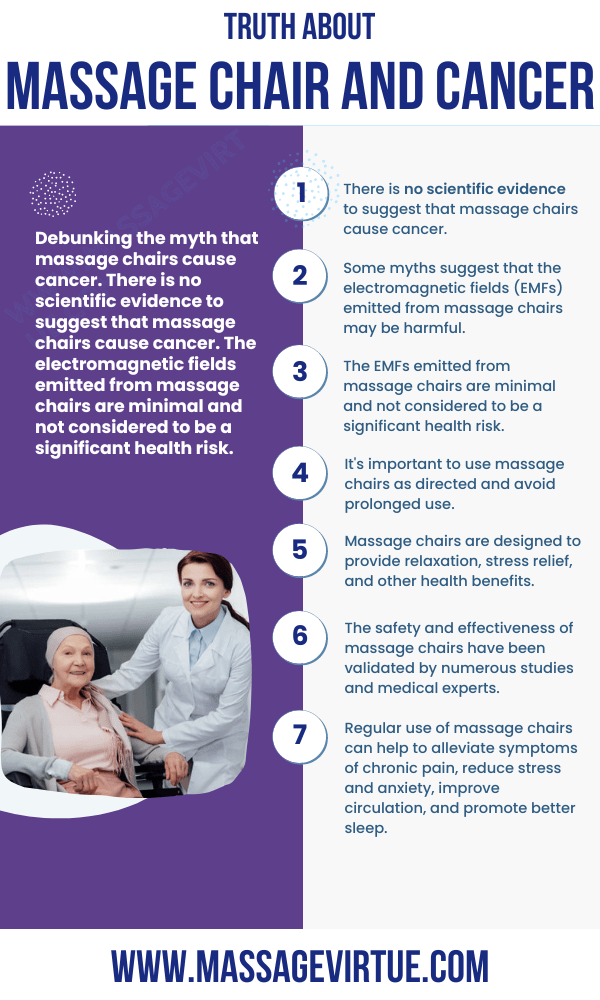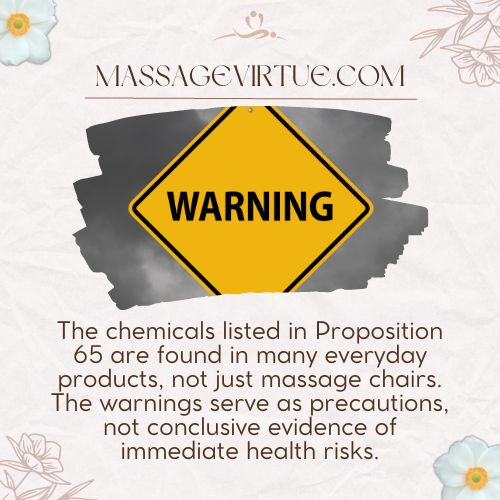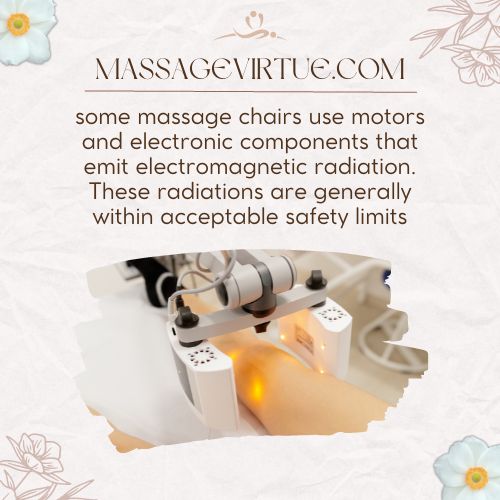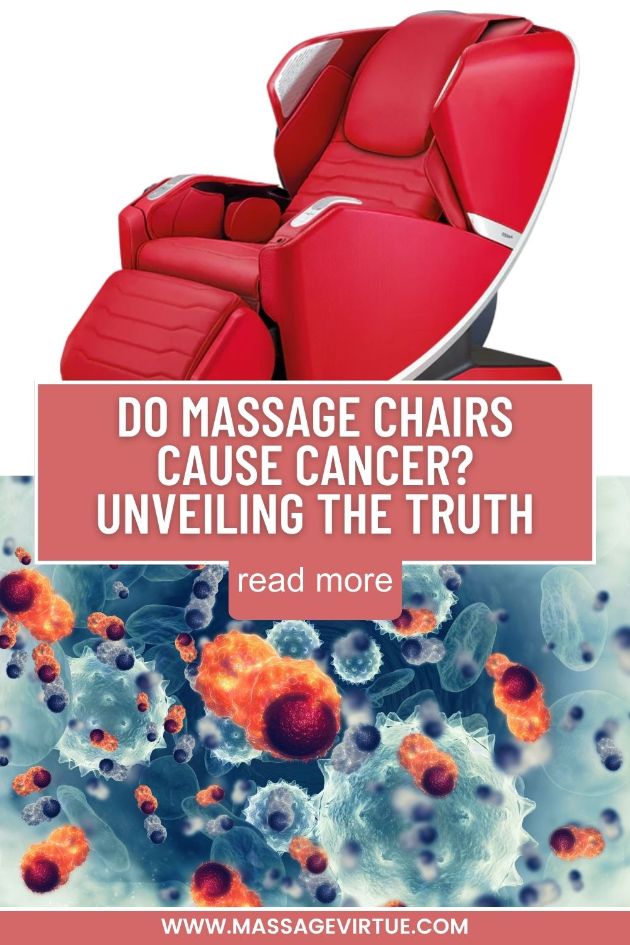Are you concerned about the potential health risks of using massage chairs? You might have heard rumors or seen warnings that suggest these chairs could cause cancer.
But do massage chairs cause cancer? Really? In this article, we will address your worries and provide you with accurate information about the safety of massage chairs.
We’ll explore the existing evidence and help you make an informed decision about whether massage chairs pose any cancer risk or not. So, let’s delve into the facts.
Can Massage Chairs Cause Cancer? (Answered)
No, there is no scientific evidence to suggest that massage chairs cause cancer. First things first, let’s take a deep breath and relax.
There’s good news – there is absolutely no scientific evidence to suggest that massage chairs cause cancer. So, if you’ve been worried about using one or have heard some worrisome whispers, rest assured that you can enjoy your massage chair without any cancer-related concerns. Massage chairs work their magic through mechanical pressure and muscle manipulation.
They offer an array of health benefits, such as relaxation, stress reduction, and improved blood circulation. However, these delightful perks have no connection whatsoever to cancer development.
Now, let’s debunk this myth once and for all. Cancer is a complex disease with multifaceted causes, primarily linked to genetic mutations and environmental factors. Rest assured, massage chairs are innocent in this matter. They don’t emit harmful radiation or any substances that could trigger cancerous cells to form.  While massage chairs are perfectly safe, we do recommend using them responsibly. Just like anything in life, moderation is key.
While massage chairs are perfectly safe, we do recommend using them responsibly. Just like anything in life, moderation is key.
Prolonged or excessive use of massage chairs, especially if you have certain medical conditions, may not be the best idea. As with any health-related questions, it’s always wise to consult a qualified healthcare professional for personalized advice.
The Proposition 65 Controversy
One of the primary concerns related to massage chairs and cancer is California’s Proposition 65.
This law requires businesses to provide warnings if their products contain chemicals known to cause cancer or reproductive harm. Some massage chairs have these warnings, but it doesn’t mean they directly cause cancer.
The chemicals listed in Proposition 65 are found in many everyday products, not just massage chairs. The warnings serve as precautions, not conclusive evidence of immediate health risks.  Remember, Proposition 65 is specific to California, and warnings may not be present in products sold outside the state. Enjoy the benefits of your massage chair with confidence.
Remember, Proposition 65 is specific to California, and warnings may not be present in products sold outside the state. Enjoy the benefits of your massage chair with confidence.
Chemicals and Electromagnetic Radiation
Massage chairs might contain trace amounts of chemicals that are listed under Proposition 65.
However, it’s essential to keep in mind that the levels of exposure are relatively low and are unlikely to pose a significant risk.
These chemicals are often present in various household items and even the air we breathe.  Similarly, some massage chairs use motors and electronic components that emit electromagnetic radiation.
Similarly, some massage chairs use motors and electronic components that emit electromagnetic radiation.
While this may sound alarming, the radiation levels are generally within acceptable safety limits and comparable to those emitted by other electronic devices like computers or smartphones.
Areas to Avoid When Using a Massage Chair by Cancer Patients
You should avoid massaging certain areas of your body while using a massage chair.
These include,
- Areas with lymph nodes removal
- Open wounds or infections
- Recent biopsy sites
- Inflammation or tenderness can increase pain and discomfort.
- Areas with radiation or chemotherapy
3 Benefits of Massage Chair for Cancer Patients
A massage chair can help you relax, relieve pain, and reduce stress. In recent years, cancer massage chairs have become increasingly popular to help people with cancer manage their disease.
The use of massage chairs for cancer patients is growing in popularity due to the potential health benefits they can provide them.
There are many potential benefits to using massage chairs for cancer patients, including:
1. Relaxation and Pain Relief
Massage chairs can help provide relaxation and comfort to those dealing with the physical pain associated with cancer treatments such as chemotherapy or radiation therapy.
The vibrations emitted from a massage chair can help reduce muscle tension, improve circulation, and provide relief from general aches and pains.
2. Stress Reduction
Reduce stress and anxiety caused by the diagnosis of a serious illness such as cancer.
The physical touch provided by massage chairs can help to calm the mind, allowing for better sleep and improved mental well-being.
3. Improved Quality of Life
Cancer massage chairs can also help cancer patients improve their overall quality of life by:
- Reducing fatigue
- Improving range of motion
- Providing an alternative form of therapy for dealing with the side effects associated with cancer treatments, such as nausea or vomiting.
Cancer Massage: The One’s Good For Cancer
1. Swedish Massage
A Swedish massage is a form of gentle and relaxing massage that uses oil or lotion to help reduce muscle tension, improve circulation, and provide overall relaxation.
The technique involves:
- Kneading
- Stroking the body
- Long gliding strokes using light to medium pressure.
This technique can help to reduce pain and improve the range of motion in the affected areas.
2. Lymphatic Drainage Massage
Lymphatic Drainage Massage is a type of massage that focuses on the lymphatic system, which is responsible for maintaining the body’s fluid balance and immune function.
- This technique involves gentle and rhythmic movements that stimulate the lymphatic vessels and lymph nodes, helping to move lymphatic fluid through the body and remove waste and toxins.
- Lymphatic Drainage Massage is commonly used to help reduce swelling and inflammation, particularly after surgery or injury. It can also help improve immune function and promote relaxation and stress reduction.
- However, like all massage techniques, it is important to consult with a healthcare provider before receiving Lymphatic Drainage Massage, particularly if you have a history of lymphedema or other medical conditions.
This massage helps to improve circulation and decrease pain due to cancer treatments such as chemotherapy or radiation therapy.
3. Myofascial Release
Myofascial release is a massage technique that involves applying sustained pressure to the myofascial connective tissue to eliminate pain and restore motion.
- Myofascial release therapy focuses on releasing tension and adhesions in the fascia, which is the connective tissue that surrounds and supports the muscles and organs.
- Myofascial release can be beneficial for treating a variety of conditions, including chronic pain, headaches, and postural problems.
Overall, massage chairs can be beneficial for cancer. It is important to choose a technique appropriate to your needs.
4. Reflexology
This massage therapy involves applying pressure to specific points on the feet, hands, and ears. 1. The theory behind reflexology is that these points correspond to different organs and systems in the body, and applying pressure to them can promote healing and relaxation throughout the body. 2. The pressure is usually applied using the fingers, thumbs, and hand techniques such as kneading, rubbing, and squeezing. 3. It is a non-invasive and natural therapy that can be used alongside other medical treatments.
This technique helps to reduce stress and can provide relief from the pain associated with treatment side effects. https://youtu.be/mpYmMMW6JF8
4 Things to Consider When Using a Massage Chair
It’s important to consider these things when using a massage chair:
| Points | Description |
|---|---|
| 1. Consult Your Doctor | Always consult your doctor before using a massage chair if you are a cancer patient. |
| 2. Be Aware of Medical Conditions | Be aware of any medical conditions or potential risks associated with the use of massage chairs. |
| 3. Adjust the Massage Chair | Ensure that the massage chair is adjusted correctly to avoid any potential injuries or problems. |
| 4. Relax and Enjoy the Experience | Try to relax and enjoy the experience while using the massage chair, as the goal is to promote comfort. |
Scientific Studies and Findings
Research on the direct link between using massage chairs and cancer is limited. The existing studies do not provide substantial evidence to support the claim that massage chairs cause cancer. The electromagnetic radiation emitted by these chairs is considered non-ionizing, which means it lacks the energy to break chemical bonds and cause cellular damage, unlike ionizing radiation (e.g., X-rays). https://youtu.be/sTWOiT7I0Fs
Reducing the Risk of Cancer from Massage Chairs
| Tips | Explanation |
| Buy from Reputable Brands | Choose well-established brands complying with safety regulations. |
| Check Proposition 65 Warnings | Understand specific chemicals if in California or buying from there. |
| Limit Usage Time | Avoid prolonged exposure by not overusing the massage chair. |
| Ventilation | Ensure a well-ventilated room to minimize chemical exposure. |
Conclusion
At the end of the day, there is currently no substantial evidence to suggest that massage chairs cause cancer. The concerns surrounding Proposition 65 warnings and electromagnetic radiation are valid but should be considered in perspective. As with any product, moderation is key, and using massage chairs in a responsible manner can provide numerous benefits without posing significant health risks.
FAQs
1. Are Massage Chairs Safe to Use?
Massage chairs are generally safe to use. Manufacturers follow strict safety standards, and there is no substantial evidence linking them to direct health risks.
2. Why Does My Chair Have a Cancer Warning?
If your massage chair has a cancer warning, it might be due to California’s Proposition 65 law. Some massage chairs contain trace amounts of chemicals on the Proposition 65 list, but this warning doesn’t imply immediate cancer risk; it’s a precautionary measure.
3. Is it OK to Sit in a Massage Chair Every Day?
While it’s generally safe to use a massage chair daily, moderation is crucial. Prolonged and excessive use may increase potential health risks. Limit usage time, follow manufacturer recommendations, and prioritize proper ventilation in the room for a safer experience.
4. Are there any Other Health Risks Associated with Massage Chairs?
As with any massage type, there are some potential risks to consider. These can include soreness and stiffness in the muscles or joints, skin irritation, or bruising. If you have a medical condition such as diabetes, arthritis, multiple sclerosis, or anything else, you should consult your doctor before using a massage chair.
5. Is Massage Safe if You Have Cancer?
Under normal circumstances, massage is generally safe for cancer patients. Consult your doctor before beginning any form of massage therapy. Some types of massage can put extra pressure on existing tumors or areas of the body that are affected by cancer.
6. Can Massage Spread Cancer to Lymph Nodes?
No, the use of a massage chair will not spread cancer to any lymph nodes. Massage is considered a safe and effective therapy for muscle relaxation and stress relief.
7. What Massage is Good for Cancer?
Swedish massage is a popular choice for cancer patients due to its light, gentle strokes that can help relax muscles and reduce stress. Other massage techniques that may help are aromatherapy massage, reflexology, or lymphatic drainage.
8. How Long After Cancer Can You Have a Massage?
Individuals should wait at least 6 months after being diagnosed with cancer before getting any type of massage to give the body enough time to heal and for any potential side effects from treatment to subside. 

